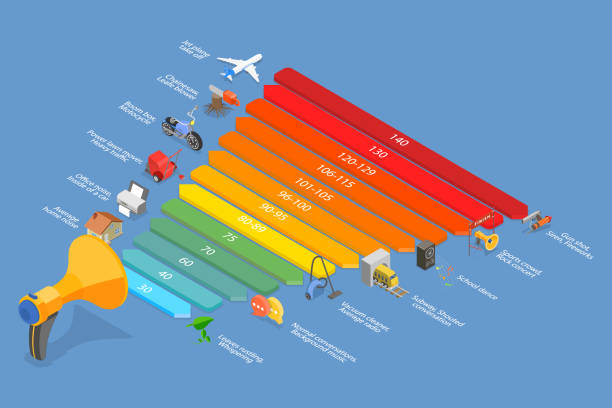Headphones and earbuds have become an essential part of modern life, providing a way to enjoy music, podcasts, audiobooks, and videos wherever we go. Whether you’re commuting, exercising, or simply relaxing at home, these audio devices are incredibly convenient. However, with their convenience comes a significant risk—hearing damage. Listening to audio at high volumes for extended periods can lead to permanent hearing loss, making it crucial to choose safe volume levels. One of the best ways to understand and monitor these levels is by using a decibel chart, which can help guide your listening habits.
What Is a Decibel Chart?
A decibel chart is a tool used to measure the intensity of sound. It uses the decibel (dB) scale to quantify how loud sounds are. The decibel scale is logarithmic, meaning that for every 10 dB increase, the sound intensity is 10 times greater. For instance, 100 dB is 10 times more intense than 90 dB. This scale helps to quantify everything from the faintest whispers to the deafening roar of a jet engine.
When it comes to headphones and earbuds, the decibel level is essential because it determines how much pressure is exerted on your eardrums. Prolonged exposure to sounds above 85 dB can cause hearing damage, so it’s crucial to be aware of the sound levels you’re exposed to when using your audio devices.
How Loud Is Too Loud?
Different sounds produce different decibel levels, and understanding these can help you avoid damaging your hearing. For example:
- 30 dB: A whisper
- 60 dB: Normal conversation
- 85 dB: Heavy traffic or a vacuum cleaner
- 100 dB: A chainsaw or loud music at a concert
- 110-120 dB: A jet engine or rock concert
Headphones and earbuds can produce sounds that reach 100 dB or higher, especially at maximum volume. Unfortunately, listening at high volumes for long periods can be particularly harmful, as the sound is delivered directly into your ears, bypassing the ear’s natural defenses.
According to health experts, listening to audio at or above 85 dB for prolonged periods can lead to permanent hearing damage. For reference, listening to music at 100 dB through headphones is equivalent to standing next to a chainsaw. Even brief exposure to sounds above 120 dB can cause immediate damage.
How to Use a Decibel Chart for Headphones
To use a decibel chart effectively for headphones and earbuds, it’s essential to understand the decibel levels associated with various listening scenarios. Here are some key factors to consider:
1. Volume Settings
Headphones and earbuds vary in how loud they can get, but many audio devices can easily exceed 85 dB at higher volume levels. To ensure you’re listening at a safe level, you should aim to keep your device at or below 60-70% of its maximum volume. This can help reduce the risk of hearing damage, especially if you’re using your headphones for extended periods.
2. Duration of Exposure
Even if you’re listening at lower volumes, the length of time you expose your ears to sound is important. The longer the exposure, the greater the risk of hearing damage. For instance, listening at 85 dB for up to 8 hours can be safe, but exposure to volumes at or above 100 dB should be limited to just a few minutes per day.
3. Use Noise-Canceling Headphones
Noise-canceling headphones are an excellent tool for reducing ambient noise, which allows you to listen at lower volumes. By eliminating background noise, you won’t feel the need to increase the volume, ultimately reducing your risk of hearing damage. Noise-canceling headphones can also provide a better listening experience in noisy environments, such as public transport or busy streets.
4. Take Regular Breaks
Even if you’re listening at safe volume levels, it’s important to give your ears regular breaks. The 60/60 rule is an easy guideline to follow—listen at 60% of the maximum volume for no more than 60 minutes at a time. After 60 minutes, take a break for at least 5 minutes before resuming your listening.
Tips for Protecting Your Hearing with Headphones
In addition to using the decibel chart to monitor your listening habits, here are some practical tips for protecting your hearing when using headphones and earbuds:
1. Lower the Volume
It may seem obvious, but one of the most effective ways to protect your hearing is simply to lower the volume. Keeping the volume at a comfortable level, where you can still enjoy your audio without straining to hear, is ideal.
2. Use Over-Ear Headphones Instead of Earbuds
Over-ear headphones are often a safer option compared to earbuds. Earbuds sit inside the ear canal, which means the sound is directly in contact with the eardrum. Over-ear headphones, on the other hand, rest over the ear, which can be a safer option for listening to loud music.
3. Check Your Hearing Regularly
Even if you’re careful with your volume settings, it’s still a good idea to check your hearing regularly. Many health professionals recommend annual hearing tests to detect any early signs of hearing loss. Early detection can make a significant difference in preventing further damage.
4. Use Volume-Limiting Devices
Many headphones and earbuds come with volume-limiting features that prevent the sound from exceeding a certain decibel level. These are especially helpful for children and those new to listening through headphones.
Conclusion
Protecting your hearing is essential, especially in a world where headphones and earbuds are an everyday part of life. By using a decibel chart, you can better understand the volume levels you’re exposed to and take steps to protect your ears. Remember, listening at high volumes for extended periods can result in permanent hearing loss. By keeping the volume at safe levels, taking regular breaks, and using noise-canceling headphones, you can continue enjoying your music and audio content without risking your hearing. Your ears will thank you for it!
